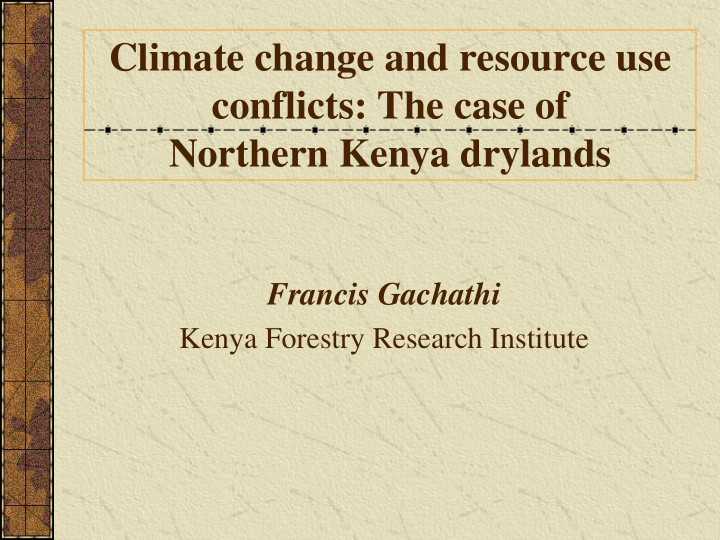



Climate change and resource use conflicts: The case of Northern Kenya drylands Francis Gachathi Kenya Forestry Research Institute
Characteristics of Kenya’s drylands Low-lying plains covering about 80% of the country with isolated hills Hot and dry climate, brief and erratic low rainfall, 150-750 mm annually - flooding Poor soils with scanty thorny vegetation cover Agriculturally (crops) marginal
Drylands of Kenya and neighbouring countries
Importance and use of Kenya’s drylands Suitable land use is nomadic pastoralism and wildlife conservation Support about 25% of the rural population Support more than 70% of the livestock population Support 90% of the national parks and game reserves
Importance and use of Kenya’s drylands (cont)
Effects of climate change in Kenya’s drylands Frequent, prolonged and severe droughts Rivers, dams, wells drying up, quality affected Migration in search of pasture and water Resource use conflicts, bloody confrontations Loss of lives in both human and livestock Reduced income, higher incidence of poverty Hunger, poor health, hopelessness Poor pastoralists turn to plant gums & resins
The aftermath of drought and cattle rustling
What are gums and resins? Gums and resins are dried exudation from stems & branches of Acacia, Commiphora and Boswellia spp. Form a major component of the vegetation in drylands, Acacia-Commiphora woodland Products of commerce, with potential to generate cash income and alternative livelihood in drylands
Major commercial gums and gum- resins resources Gum arabic Acacia senegal Acacia seyal Myrrh Commiphora myrrha Hagar (opoponax) Commiphora holtziana Frankincense Boswellia neglecta
Distribution of commercial gums and gum-resins resources
Gum arabic from Acacia senegal var. kerensis Dried exudates from stems or branches of A. senegal Whole, round tears, pale to orange in colour, matt surface texture
Gum arabic from Acacia seyal Dried exudates from stems or branches of A. seyal More friable, rarely in whole lumps, pale to orange in colour, with brittle surface texture
Collectors of gum arabic Gums collected by women and children Transporting gum arabic Sorting gum arabic
Uses of Gum arabic Local – eaten as food (human & animals), medicine for various diseases Commercial – food and confectionery - prevent crystallization, emulsifier and stabilizer Pharmaceutical – coating/binding and suspending agent Adhesives – office glue, Paint – viscosity, Printing – prevent oxidation of plates
myrrh Myrrh from Commiphora myrrha
Uses of myrrh Oily gum resin exudates from stems or branches of C. myrrha Colour variable from red, brown to dark brown Local uses – ink used in quranic schools, burn to repel snakes and insects, medicine Commercial uses – essential oil, cosmetics, flavours, medicines, antiseptics
Hagar (opoponax) from Commiphora holtziana Main stem/bark Tree Gum hagar
Uses of hagar (opoponax) Oily gum resin exudates from stems or branches of C. holtziana Colour variable, yellow to dark brown Local uses – acaricide against ticks, treats snake and scorpion bites, foot rot, mange Commercial uses – essential oils, herbal medicine in China, cosmetics
Collectors of myrrh and hagar (Malmaley)
Frankincense from Boswellia neglecta White incense Tree Black incense Branch with angled fruits
Uses of frankincense Gum resin from stems or branches of Boswellia neglecta , small droplets harden to form nodules of large lumps Generally of two types, black and white Local uses – chewing gum, burnt as incense, perfumes, medicine Commercial uses – essential oil in perfumery, cosmetics and flavour industries
Collectors of frankincense Collected by women and children Collecting frankincense Sorting frankincense
The hills in the drylands
The importance of the hills in the drylands Water catchments, vital for the people, livestock and wild animals Dry season fodder, food plants, herbal medicines Hold unique forests with different flora and fauna Herders converge for water pasture wild food plants and medicines – conflicts
Opportunities in gums and resins in Northern Kenya drylands Gums and resins are Non Wood Forest Products Sustainably exploited for household income and economic development in drylands Conserve biological diversity, increase overall productivity of land Create new jobs and alternative livelihood opportunities for pastoralists in drylands Reduce dependence on livestock hence reduce resource use conflict
Conservation of the hilltop forests All conservation initiatives for the hilltop forests must be people-focused and community-driven guided by proper understanding of the interaction between socio-cultural and environmental factors affecting the various community livelihoods in order to reduce conflict in resource use.
Ahsante Sana Thank you May God Bless You
Recommend
More recommend